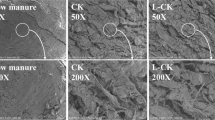Abstract
Four kinds of indigenous seaweed were employed for assessing their soluble cadmium biosorption performance. Sargassum angustifolium revealed the greatest capacity in the range of equilibrium cadmium concentration lower than 0.5mmol l−1. It was further examined by optimization, equilibrium, kinetic and thermodynamic studies. It was found that1 g l−1 biosorbent at initial pH of 6 and 38 °C revealed the highest Cd2+ uptake. Kinetic studies revealed that the Cd2+ biosorption included a two-stage mechanism with an initial rapid stage during the first 30 min where ion exchange was the dominant mechanism. The process gradually reached equilibrium after 40-50 min of contact where the metal adsorption occurred too low due to the intraparticle diffusion. However, it was not the sole rate-limiting step. The pseudo-second order kinetic model, unlike the pseudo-first order, excellently described the experimental data in the whole range of contact time. The Langmuir isotherm model was more successful in describing the equilibrium data than the Freundlich and D-R models. Using this isotherm model, a relationship was proposed to predict the dose of biosorbent needed for removing specific initial cadmium concentration from aqueous solution or to meet a desire equilibrium cadmium concentration. The spontaneity and endothermicity as well as increasing randomness at the solid/solution interface during the biosorption were revealed by means of the thermodynamic studies.
Similar content being viewed by others
References
R. Herrero, B. Cordero, P. Lodeiro, C. Rey-Castro and M. E. Sastre de Vicente, Mar. Chem., 99, 106 (2006).
Z.R. Holan, B. Volesky and I. Prasetyo, Biotechnol. Bioeng., 41, 819 (1993).
Z. Aksu, Sep. Purif. Technol., 21, 285 (2001).
R. Say, A. Denizli and M. Yakup Arica, Bioresour. Technol., 76, 67 (2001).
S. A. Jafari, S. Cheraghi, M. Mirbakhsh, R. Mirza and A. Maryamabadi, Clean, 43, 118 (2015).
P. X. Sheng, L.H. Tan, J. P. Chen and Y. P. Ting, J. Dispersion Sci. Technol., 25, 679 (2005).
S. A. Jafari and S. Cheraghi, Int. Biodeterior. Biodegrad., 92, 12 (2014).
R. H. S. F. Vieira and B. Volesky, Int. Microbiol., 3, 17 (2000).
M. E. Romero-González, C. J. Williams and P. H. Gardiner, Environ. Sci. Technol., 35, 3025 (2001).
M. A. Hashim and K.H. Chu, Chem. Eng. J., 97, 249 (2004).
M.T. K. Tsui, K. C. Cheung, N. F.Y. Tam and M. H. Wong, Chemosphere, 65, 51 (2006).
B. Volesky and Z. R. Holan, Biotechnol. Progr., 11, 235 (1995).
J. Wang and C. Chen, Biotechnol. Adv., 27, 195 (2009).
E. Fourest and B. Volesky, Environ. Sci. Technol., 30, 277 (1995).
B. Southichak, K. Nakano, M. Nomura, N. Chiba and O. Nishimura, Water Sci. Technol., 58, 697 (2008).
G.E. Boyd, J. Schubert and A.W. Adamson, J. Am. Chem. Soc., 69, 2818 (1947).
D. Kratochvil and B. Volesky, Trends Biotechnol., 16, 291 (1998).
E. Romera, F. González, A. Ballester, M. L. Blázquez and J. A. Munoz, Bioresour. Technol., 98, 3344 (2007).
C.C.V. Cruz, A. C. A. da Costa,_C. A. Henriques and A. S. Luna, Bioresour. Technol., 91, 249 (2004).
R. Vimala and N. Das, J. Hazard. Mater., 168, 376 (2009).
A. Chatterjee and L. Ray, J. Sci. Ind. Res., 67, 629 (2008).
P. Lodeiro, J.L. Barriada, R. Herrero and M.E. Sastre de Vicente, Environ. Pollut., 142, 264 (2006).
B. Benguella and H. Benaissa, Water Res., 36, 2463 (2002).
F. Zan, S. Huo, B. Xi and X. Zhao, Front. Environ. Sci. Eng., 6, 51 (2012).
J.T. Matheickal, Q. Yu and G. M. Woodburn, Water Res., 33, 335 (1999).
R. Leyva-Ramos, J.R. Rangel-Mendez, J. Mendoza-Barron, L. Fuentes-Rubio and R.M. Guerrero-Coronado, Water Sci. Technol., 35, 205 (1997).
J. K. Park, Y. B. Jin and H.N. Chang, Biotechnol. Bioeng., 63, 116 (1999).
A. Saeed, M.W. Akhter and M. Iqbal, Sep. Purif. Technol., 45, 25 (2005).
A. E. Ofomaja and Y. S. Ho, J. Hazard. Mater., 139, 356 (2007).
A. E. Ofomaja, Bioresour. Technol., 101, 5868 (2010).
Y. S. Ho, Bioresour. Technol., 96, 1292 (2005).
Y. Liu, Colloids Surf., A, 274, 34 (2006).
A. Benhammou, A. Yaacoubi, L. Nibou and B. Tanouti, J. Colloid Interface Sci., 282, 320 (2005).
A.M. El-Kamash, A.A. Zaki and M.A. El Geleel, J. Hazard. Mater., 127, 211 (2005).
D. Mohan and K. P. Singh, Water Res., 36, 2304 (2002).
T. Gosset, J. L. Trancart and D. R. Thévenot, Water Res., 20, 21 (1986).
S. K. Milonjic, J. Serb. Chem. Soc., 72, 1363 (2007).
Y. Liu, J. Chem. Eng. Data, 54, 1981 (2009).
D. Gialamouidis, M. Mitrakas and M. Liakopoulou-Kyriakides, J. Hazard. Mater., 182, 672 (2010).
A. Sari and M. Tuzen, J. Hazard. Mater., 152, 302 (2008).
Y. S. Ho and G. McKay, Process Biochem., 34, 451 (1999).
A. Sinha, K. K. Pant and S. K. Khare, Int. Biodeterior. Biodegrad., 71, 1 (2012).
A. El-Sikaily, A. E. Nemr, A. Khaled and O. Abdelwehab, J. Hazard. Mater., 148, 216 (2007).
G. McKay, M. S. Otterburn and J. A. Aga, Water Air Soil Pollut., 36, 381 (1987).
Author information
Authors and Affiliations
Corresponding author
Rights and permissions
About this article
Cite this article
Jafari, S.A., Jamali, A. & Hosseini, A. Cadmium removal from aqueous solution by brown seaweed, Sargassum angustifolium . Korean J. Chem. Eng. 32, 2053–2066 (2015). https://doi.org/10.1007/s11814-015-0013-2
Received:
Accepted:
Published:
Issue Date:
DOI: https://doi.org/10.1007/s11814-015-0013-2




